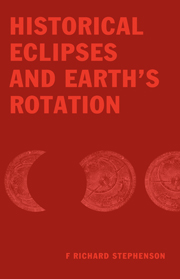Book contents
- Frontmatter
- Contents
- Principal Symbols
- 1 Variations in the length of the day: a historical perspective
- 2 Tidal friction and the ephemerides of the Sun and Moon
- 3 Pre-telescopic eclipse observations and their analysis
- 4 Babylonian and Assyrian records of eclipses
- 5 Investigation of Babylonian observations of solar eclipses
- 6 Timed Babylonian lunar eclipses
- 7 Untimed Babylonian observations of lunar eclipses: horizon phenomena
- 8 Chinese and other East Asian observations of large solar eclipses
- 9 Other East Asian observations of solar and lunar eclipses
- 10 Records of eclipses in ancient European history
- 11 Eclipse records from medieval Europe
- 12 Solar and lunar eclipses recorded in medieval Arab chronicles
- 13 Observations of eclipses by medieval Arab astronomers
- 14 Determination of changes in the length of the day
- Appendix A Timed data
- Appendix B Untimed data
- References
- Acknowledgements
- Index of eclipse records
- Index of places of observation
- Name Index
- Subject index
11 - Eclipse records from medieval Europe
Published online by Cambridge University Press: 13 November 2009
- Frontmatter
- Contents
- Principal Symbols
- 1 Variations in the length of the day: a historical perspective
- 2 Tidal friction and the ephemerides of the Sun and Moon
- 3 Pre-telescopic eclipse observations and their analysis
- 4 Babylonian and Assyrian records of eclipses
- 5 Investigation of Babylonian observations of solar eclipses
- 6 Timed Babylonian lunar eclipses
- 7 Untimed Babylonian observations of lunar eclipses: horizon phenomena
- 8 Chinese and other East Asian observations of large solar eclipses
- 9 Other East Asian observations of solar and lunar eclipses
- 10 Records of eclipses in ancient European history
- 11 Eclipse records from medieval Europe
- 12 Solar and lunar eclipses recorded in medieval Arab chronicles
- 13 Observations of eclipses by medieval Arab astronomers
- 14 Determination of changes in the length of the day
- Appendix A Timed data
- Appendix B Untimed data
- References
- Acknowledgements
- Index of eclipse records
- Index of places of observation
- Name Index
- Subject index
Summary
Introduction
For the purpose of this chapter, the term ‘medieval’ will be loosely interpreted to mean the period between the close of the classical age in Europe (c. AD 500) and the beginning of the telescopic era. It thus includes the Renaissance. Numerous observations of both solar and lunar eclipses were recorded in Europe during this period, especially after AD 1000. In most cases, the date is accurately reported and the precise place of observation is known. However, with only a few exceptions, times were only crudely estimated to the nearest hour or so. Thus most observations may effectively be regarded as untimed.
As discussed in chapter 3, untimed lunar eclipses are of negligible value for the determination of ΔT (unless it is clearly implied that the Moon rose or set eclipsed). Most of this chapter will be devoted to the investigation of solar obscurations in which the Sun was either totally or very largely covered. In section 11.9, a few careful timings of solar eclipses from the early fourteenth century will also be analysed. Finally, in section 11.10, an eighth century report of an occultation of the planet Jupiter by the eclipsed Moon – a very rare event – will be discussed.
Historical sources
European reports of solar eclipses (as well as lunar obscurations) from the Middle Ages and Renaissance are mainly found in historical works, notably chronicles; only a few observations are reported in astronomical treatises.
- Type
- Chapter
- Information
- Historical Eclipses and Earth's Rotation , pp. 376 - 430Publisher: Cambridge University PressPrint publication year: 1997



